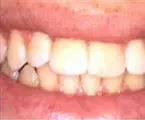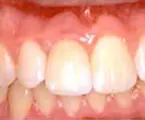

When one tooth can be replaced with a removable appliance, the looks, function and convenience of a permanent replacement are worlds better. Today, implants are so predictable that experts often recommend them in place of a bridge to replace single missing teeth. A front tooth dental implant closely resembles a real tooth root, providing the alveolar bone with the stimulation needed, so bone loss doesn’t occur, ensuring your jawbone remains strong and healthy. Front tooth implant treatment is preplanned, the actual surgery for placing a front tooth implant is very quick, and you may only require local anesthetic. You will receive a temporary tooth on the same day. Once healing is complete, your new permanent front tooth is made and fitted.

Implant
inserted to
replace
missing front
tooth

X-ray of
implant with crown
cemented

Restoration
completed with
crown placed

Close-up of beautiful
cosmetic result.
It is impossible to
tell which tooth was
replaced with the
implant/crown.
Drilling down the adjacent natural teeth to make crowns isn’t necessary.
Flossing is easier because the teeth remain separate.
The entire bridge must be removed if it fails, whereas implants are standalone.
Implants can’t decay, the main reason bridges fail.
Implants are highly useful when the natural teeth aren’t strong enough to support a bridge, or where there are no teeth available to connect with a bridge. That’s why they are a great alternative to a removable appliance and offer the only solution for a permanent restoration.
Using our facility’s state-of-the-art technology, our team of Periodontists are able to recreate a smile that is uniquely you.
Multiple Dental Implants are surgically inserted into your jaw and then fitted with teeth designed to mimic your natural teeth. Now you will be able to smile and eat with confidence.
With our dental implants, you will be able to speak, eat and laugh as though they were your native teeth – because they might as well be.
Four implants supporting bridge
X-ray of the implants in place
Completed implant supported bridge
No cavities
No extraneous tooth damage
No slipping, clicking or shifting
No difficult and costly retreatment work
Conventional dentures provide only marginal chewing ability due in part to their looseness. Implants, on the other hand, offer unbeatable support for removable appliances. Interestingly, implants were originally developed to help those with ill-functioning dentures.
Five lower implants supporting a bar to which the denture clips
Lower denture
Underside of denture showing clips
Substantial improvement of function and comfort thanks to more secure retention and fit
Less stress on any remaining natural teeth that hold the appliance
Reduction or elimination of bone shrinkage where implants are placed
With implant placement, there is generally little postoperative pain because the bone receiving the implant has no nerve endings. Patients usually only ngle thooxperience minor discomfort in the small incision of the gum. After the 3-6 months it takes for the implants to bond with the jawbone, the post is placed. The placement of the final crown or appliance marks the last phase of the process.
The major concern with implant placement is the impingement of the mandibular nerve, found in the lower back jaw. Damaging this nerve may cause permanent numbness on that side of the lower lip. However, we carefully evaluate the nerve position with x-rays, minimizing the risk of injury.
Infection ranks as another complication of implant placement. We believe this may be due to bacteria that were already present in the bone before the implant was placed. Regardless of these small risks, success rate of implant placement ranges from 92-97%. Though certain health issues may come into play, implants can successfully be placed in adults of any age. Please consult with your dentist to see if you are a good candidate for dental implants.
Ideal candidates for implants must be in good general and oral health. Successful bone height and width to hold the implant are imperative. There must also be sufficient bone available above the mandibular nerve in the lower jaw. We determine this by a clinical exam and x-rays. Our team now has the ability to increase the amount of bone with ridge augmentation procedures if insufficient bone exists. The proximity of the sinus may reduce the amount of bone available in the upper arch. In select cases, a CAT scan may be needed to answer questions regarding bone anatomy.
Sinus position too low to allow placement of implant
Sinus lift procedure adds bone to sinus floor, allowing implant